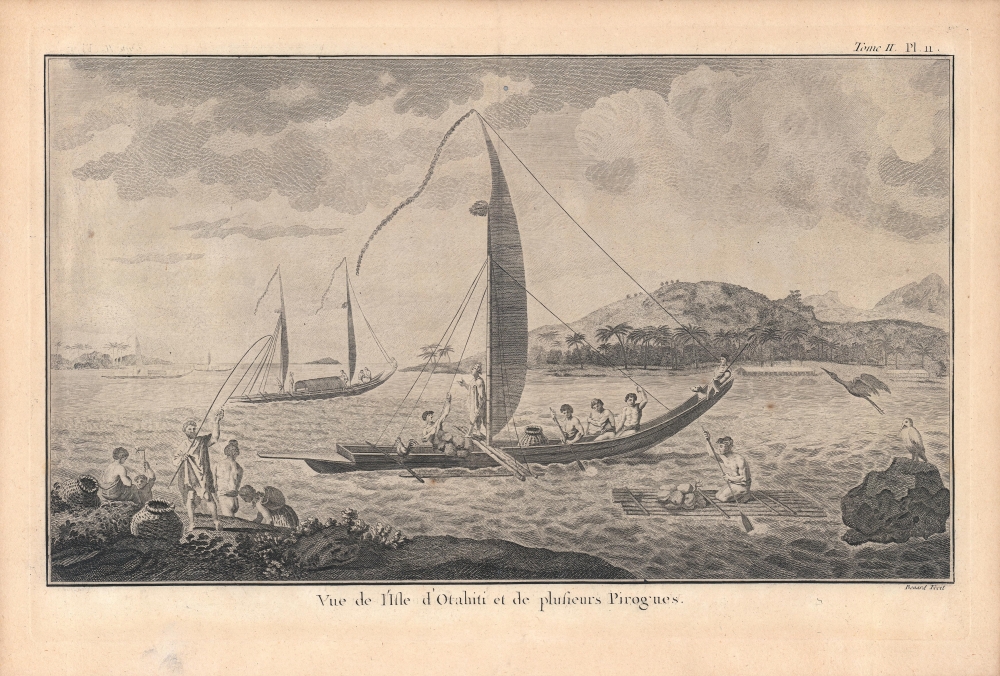1774 Hawkesworth / Benard View of Canoes Off Tahiti
TahitiCanoes-hawkesworth-1774
Title
1774 (undated) 8 x 13.75 in (20.32 x 34.925 cm)
Description
A Closer Look
This serene view of indigenous Tahitians on land and water was illustrated by Sydney Parkinson, who produced hundreds of drawings, of both dramatic and mundane scenes, during Cook's first voyage. Both the figures on the boats and on the beach are engaged in fishing. In the background at right sit huts belonging to a village.Cook's First Voyage
This view was drawn during the 1768 - 1771 voyage of James Cook on the H.M.S. Endeavour, Cook's first major voyage of discovery. Ostensibly its purpose was to observe and record the 1769 transit of Venus across the Sun, which, when combined with other measurements, would enable an accurate triangulation of the distance of between the Earth and the Sun. Tahiti, visited by British captain Samuel Wallis in 1767, was in a sense the destination of Cook's voyage as it was the location chosen for observing the transit of Venus.After departing Plymouth on August 26, 1768, the Endeavour travelled to South America, rounded Cape Horn, and sailed to Matavai Bay on Tahiti, arriving on April 13, 1769. With enough time to spare before Venus' transit, an observatory and other structures were built at what came to be called Point Venus. However, due to the limitations of instruments at the time, the observations did not prove as conclusive as had been hoped.
The secondary secret purpose of the voyage, as assigned by the Admiralty, was to search the south Pacific for signs of the long speculated rich southern continent of Terra Australis. While Cook was unable to find the non-existent continent, he did accurately map numerous Polynesian islands, New Zealand, and the eastern coast of Australia. Cook claimed eastern Australia (then New Holland) for England, but the annexation was not immediately recognized by the crown. Upon his return to England in 1771, Cook's journals were compiled and published by John Hawkesworth, turning Cook into an instant hero, and heralding a new era of scientific exploration.
Publication History and Census
This view was drawn by Sydney Parkinson and engraved by Robert Benard as Plate 11 in Volume II of Relation des voyages entrepris par ordre de Sa Majesté Britannique, actuellement regnante, pour faire des découvertes dans l'hémisphère méridional, a 1774 French translation of the book An Account of the Voyages… published the previous year by John Hawkesworth. The view is not independently cataloged among the holdings of any institution, while Hawkesworth's entire text is more widely distributed in institutional holdings, though somewhat less so in the French translation.CartographerS
John Hawkesworth (c. 1715 - November 16, 1773) was an English born writer and editor born London. Hawkesworth, who is said to have been self educated, succeeded Samuel Johnson as the parliamentary debate compiler for "Gentleman's Magazine". He was a deeply religious and moral map who brilliant defense of morality earned him an LL. D degree from the Archbishop of Canterbury. Hawkesworth went on to publish a series of scholarly books and essays including a 12 volume edition of Jonathan Swift's work. In 1772 Hawkesworth was commissioned by the Admiralty to compile and edit James Cook's journals. The resultant work An Account of the Voyages undertaken ... for making discoveries in the Southern Hemisphere was one of the first ethnographic account of the South Seas and was widely published in England and abroad. Though highly influential, Hawkesworth's work received heavy criticism from scholars who claim that he liberally altered much of the text in the name of morality. More by this mapmaker...
Robert Bénard (1734 - c. 1785) was a French engraver. Born in Paris, Bénard is best known for supplying a significant number of plates (at least 1,800) for the Encyclopédie published by Diderot and Alembert. He also is remembered for his work with the Académie des Sciences, most notably the Descriptions des Arts et Métiers Learn More...

